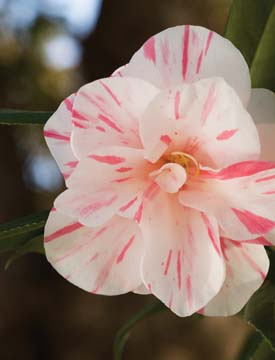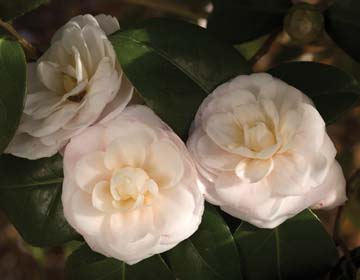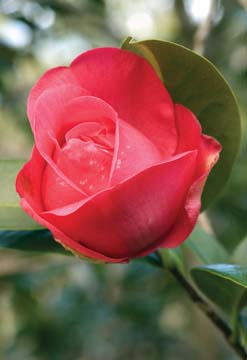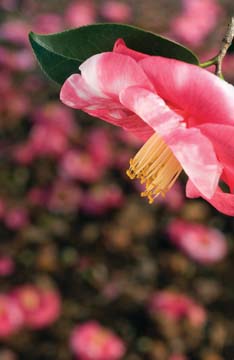Winter Blooms
BY Emily Brown
Though camellias are extremely common in the United States especially on North Carolinas southeastern coast the flower has native origins in Asia. In fact only two species of camellias are typically found in the U.S.: Camellia sasanqua and Camellia japonica (the type on display at Airlie Gardens). Camellia japonicas are distinguishable because of their vibrant colors and glossy green leaves. Though we know them for their stunning blooms japonicas are actually small shrubs and trees. They produce flowers up to five inches wide with yellow centers and round overlapping petals much like roses. Camellias can grow up to 30 feet in height and the shade of the flowers can vary from white to pink to red. Camellia cultivating has become increasingly popular. There are dozens of Web sites where camellia fans can exchange tips and techniques for creating beautiful blooms. Camellia lovers work to perfect the art of selection and breeding each time hoping to create a dazzling never-before-seen bloom. Because of gardeners growing fascination with camellias there are now thousands of varieties of Camellia japonica each as varied and special as the person who created it. A large number of camellia cultivars can be found right here on the Azalea Coast. The Tidewater Camellia Club holds meetings and competitions from September to April including their big camellia show in February. A nonprofit group of gardeners founded in the early 1950s the Tidewater Camellia Club promotes the cultivation of these gorgeous flowers in the Wilmington area. For more information contact Alma Buffkin at (910) 371-9567 or visit www.tidewatercamelliaclub.org. Camellias prefer acidic soil with plenty of moisture. Andy Johnson superintendent of gardening at Airlie Gardens says “Camellias grow best in part-sun part-shade environments. They dont require a whole lot of sun. Since they are hardy plants camellias grow best in cold weather.” Though most people know these blooms simply as camellias “camellia” actually refers to the plants genus. There are at least 250 different species of camellias worldwide though the number has been debated in recent years. Camellia japonica is the type typically seen in the United States. Of these various species there are thousands of varieties. Camellias fall under the family of Theaceae or tea. Camellias can literally outlive the humans who plant them. As long as conditions are adequate (weather soil etc.) camellias will thrive and bloom every winter. Some camellias like those at Airlie Gardens have reached their 100th birthday and are still healthy! When the garden was first established in the early 1900s it contained the work of almost every famous cultivar of that time drawing crowds to Wrightsville Beach to enjoy the beautiful flowers. At its peak in the 1920s the garden was said to contain more than 5 000 specimens of camellias. Now over a century later guests from near and far are still fascinated by Airlies exquisite display of winter blooms. Some of the flowers have thrived since they were first planted 100 years ago. “This age is not uncommon for well-maintained camellias ” says Andy Johnson superintendent of gardening at Airlie. Though these faithful winter jewels are slow-growers camellias are a constant reminder that good things come to those who wait.  The winter season brings with it a whole host of joys: Holiday celebrations hot cocoa and roaring fires warm the hearts and homes of most everyone during the chilly months. But outside things arent always so cheery. Cold winds and low temperatures cause the ground to grow dry and brittle. Healthy plants become brown and furrowed; everything seems to be decaying. For those who like to spend time outdoors the span between bitter winter weather and the refreshing sights of spring can feel like an eternity. Fortunately there is hope. It comes in the form of camellias winter-blooming flowers with petals vibrant enough to make even the gloomiest December days seem bright and sunny.
The winter season brings with it a whole host of joys: Holiday celebrations hot cocoa and roaring fires warm the hearts and homes of most everyone during the chilly months. But outside things arent always so cheery. Cold winds and low temperatures cause the ground to grow dry and brittle. Healthy plants become brown and furrowed; everything seems to be decaying. For those who like to spend time outdoors the span between bitter winter weather and the refreshing sights of spring can feel like an eternity. Fortunately there is hope. It comes in the form of camellias winter-blooming flowers with petals vibrant enough to make even the gloomiest December days seem bright and sunny.Origin
Profile
Name
 Camellias take their unique name from the Jesuit botanist Georg Joseph Kamel who worked in Asia during the 17th century. Kamel is said to have introduced the flowers to the Western Hemisphere.
Camellias take their unique name from the Jesuit botanist Georg Joseph Kamel who worked in Asia during the 17th century. Kamel is said to have introduced the flowers to the Western Hemisphere.Hobby
Tidewater Camellia Club
Facts
 Far away from Wrightsville Beach different species of camellias are grown and used for purposes other than their exquisite beauty. Camellia sinensis found primarily in Asia is grown for its leaves which are boiled to make tea. Some species of camellias are even used in Asian cusine. In America Alabama has adopted the camellia as its state flower demonstrating just how versatile and loved these flowers are.
Far away from Wrightsville Beach different species of camellias are grown and used for purposes other than their exquisite beauty. Camellia sinensis found primarily in Asia is grown for its leaves which are boiled to make tea. Some species of camellias are even used in Asian cusine. In America Alabama has adopted the camellia as its state flower demonstrating just how versatile and loved these flowers are.Cultivation
Science
Life Span
Winter Garden
 Looking for a break in the monotony of gloomy winter weather? The splash of vitality youre craving may be closer than you think. The collection of camellias at Airlie Gardens blooms every November and continues to do so until April. This unconventional blooming season spanning both the fall and winter months earns the camellia garden its nickname of “The Winter Garden.” Though there are hundreds of species of camellias worldwide the one most commonly found in the United States Camellia japonica is the one on display at Airlie. Several varieties of japonica comprise Airlies two-acre camellia garden providing guests with a breathtaking glimpse of lush vivid colors during a season infamous for its grey days. Also in the garden are holly ferns indica tulips Japanese maples and other plants that complement the camellias.
Looking for a break in the monotony of gloomy winter weather? The splash of vitality youre craving may be closer than you think. The collection of camellias at Airlie Gardens blooms every November and continues to do so until April. This unconventional blooming season spanning both the fall and winter months earns the camellia garden its nickname of “The Winter Garden.” Though there are hundreds of species of camellias worldwide the one most commonly found in the United States Camellia japonica is the one on display at Airlie. Several varieties of japonica comprise Airlies two-acre camellia garden providing guests with a breathtaking glimpse of lush vivid colors during a season infamous for its grey days. Also in the garden are holly ferns indica tulips Japanese maples and other plants that complement the camellias.
